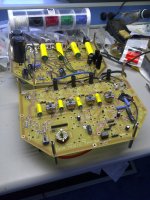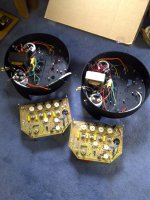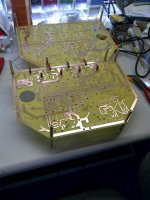Hi all,
I am new here and can't find anything related to my problem in the archives. I have a pair of Thor TPA 60 mono block amps. Tubes are 4 el34/kt77 1-12at7, 1-12au7, 1-12bh7a. One amp has had a problem of occasionally, when driven fairly hard the bias starts to fluctuate rapidly on all 4 tubes. It will swing from 30 to 600ma. I lowered the bias from 240mv to 220mv and the problem stoppd for a while. Now it does this with bias pots all the way down and no signal after about 2 minutes of being turned on. I have also had a problem with the same amp causing the woofer in my speaker to randomly move in and out without music being played. This does not happen in the other amp. I have sent this amp into Thor twice. The first time they replaced a bias control on V2 the 12au7, then the second time a relay on the power input. It worked fine for several months and now is back to where it was before. V2 seems to be where my problem is. I had a rushing sound over the weekend and it changed or went away when I would wiggle V2. I thought I had a bad tube but after changing it the bias started this rapid fluctuation again. The tube rushing sound did stop though. Any ideas?
Thanks,
Russ
I am new here and can't find anything related to my problem in the archives. I have a pair of Thor TPA 60 mono block amps. Tubes are 4 el34/kt77 1-12at7, 1-12au7, 1-12bh7a. One amp has had a problem of occasionally, when driven fairly hard the bias starts to fluctuate rapidly on all 4 tubes. It will swing from 30 to 600ma. I lowered the bias from 240mv to 220mv and the problem stoppd for a while. Now it does this with bias pots all the way down and no signal after about 2 minutes of being turned on. I have also had a problem with the same amp causing the woofer in my speaker to randomly move in and out without music being played. This does not happen in the other amp. I have sent this amp into Thor twice. The first time they replaced a bias control on V2 the 12au7, then the second time a relay on the power input. It worked fine for several months and now is back to where it was before. V2 seems to be where my problem is. I had a rushing sound over the weekend and it changed or went away when I would wiggle V2. I thought I had a bad tube but after changing it the bias started this rapid fluctuation again. The tube rushing sound did stop though. Any ideas?
Thanks,
Russ
Poor Output tubes could be the cause as well, especially if they're running at high Pa and/or high Rg.
Swap the output tubes between the channels and re-adjust bias. If you can track down the problem to a specific set of tubes please have them checked with a tube-tester, because each time the anode current skyrockets the tubes are overloaded and even if they're still good they will wear prematurely. The question remaining is if the tubes are experiencing thermal runaway under normal operating conditions or if there is an error like a bad -ug1 pot in the amplifier.
Swap the output tubes between the channels and re-adjust bias. If you can track down the problem to a specific set of tubes please have them checked with a tube-tester, because each time the anode current skyrockets the tubes are overloaded and even if they're still good they will wear prematurely. The question remaining is if the tubes are experiencing thermal runaway under normal operating conditions or if there is an error like a bad -ug1 pot in the amplifier.
may be a symptom of high frequency oscillation.rushing sound...
First thing I'd be checking is all the usual suspects. Be sure your speaker posts are tight specially the grounds, and check all resistor values and check the star ground and be SURE it's tight and look for any oxidation on the ground points. Be sure the caps are discharged, 400V on a cap can get REAL painful or worse. Weird things can happen even if one of the speaker posts are loose. Start with the obvious little things first specially since it's been in for service. I would think the service folks tested the tubes... but you can never assume anything.
Connectors look good, grounds are tight, resistor values good, clean the switches and pots, then look to the caps and test them as well (discharge first with a high value 10W or so resistor and do it twice) then test the caps. One hand in your pocket and be fresh. You sound like you MAY know what you are doing but there's killer voltage there even with the amp turned off. You wouldn't want to find your bleeder resistor took a dump. Best to just bleed the voltage from the caps first before poking around.
Cheers,
Bob
Connectors look good, grounds are tight, resistor values good, clean the switches and pots, then look to the caps and test them as well (discharge first with a high value 10W or so resistor and do it twice) then test the caps. One hand in your pocket and be fresh. You sound like you MAY know what you are doing but there's killer voltage there even with the amp turned off. You wouldn't want to find your bleeder resistor took a dump. Best to just bleed the voltage from the caps first before poking around.
Cheers,
Bob
Hi all,
I am new here and can't find anything related to my problem in the archives. I have a pair of Thor TPA 60 mono block amps. Tubes are 4 el34/kt77 1-12at7, 1-12au7, 1-12bh7a. One amp has had a problem of occasionally, when driven fairly hard the bias starts to fluctuate rapidly on all 4 tubes. It will swing from 30 to 600ma. I lowered the bias from 240mv to 220mv and the problem stoppd for a while.
I don't see the meaning of "240mv to 220mv". Is this read across a current sensing resistor? Is there one per valve or is this reading for the sum of all? Do you mean that each and every valve is fluctuating, or the sum?
Anyway, it would be good to measure the actual bias voltage (Vgk). If it is also fluctuating then you might investigate whether this is caused by grid leakage, coupling cap leakage, or by a fault in the bias circuit. If it is not fluctuating then the fault must be with the valve, or possibly with its load.
Now it does this with bias pots all the way down and no signal after about 2 minutes of being turned on.
Without a circuit diagram, "all the way down" could mean anything, depending on the range of adjustment available.
If the problem arises after a while, regardless of bias setting, then you should look at and around whatever gets hot in that time. That would include all parts of the bias circuit, components attached to the valve base, and the power transformer heater and bias windings.
If the only problem is a repeatedly failing bias circuit, then it's likely that some components are incorrectly specified. Also, bias circuits should generally fail safe, so perhaps a better circuit is needed.
I have also had a problem with the same amp causing the woofer in my speaker to randomly move in and out without music being played. This does not happen in the other amp. I have sent this amp into Thor twice. The first time they replaced a bias control on V2 the 12au7, then the second time a relay on the power input. It worked fine for several months and now is back to where it was before. V2 seems to be where my problem is. I had a rushing sound over the weekend and it changed or went away when I would wiggle V2. I thought I had a bad tube but after changing it the bias started this rapid fluctuation again. The tube rushing sound did stop though. Any ideas?
Need a diagram, obviously. Failed cathode resistor or its bypass cap, likely if they are attached to the valve base because they get hot. Valve could fail in consequence, and then a new valve solves one problem but not the other, like changing a fuse without rectifying the cause.
What's the link between all these problems? Is the amp direct coupled? Or are some coupling caps suspect too?
Ian
Thanks to everyone who replied.
I am in way over my head here. What I do know is it is not motorboating. I tried a 3rd quad of el34 tubes and the flucuations started almost immediatly as the amp was warming up.
All connections are good. Tube sockets were replaced by the tech before I ever bought the amp. Everything inside and out is tight.
Plasticisgood: The amp has a built in LED meter to read the bias on each of the 4 tubes. Flipping a switch shunts the input to ground and allows me to read and adjust the bias on each tube individually. With all pots turned down I got the following readings from left to right 0.68, 0.97, 115, 140. If I switch the tubes around the value of that tube pretty much stays the same without regard to what position it is in. I am attempting to add some pics of when the amp was rebuilt. I don't have schematics but could possibly get them from the tech.
This amp has completely new boards installed by the new owner of the company. It is the only pair of amps with this new board and they installed most of the old components on to it. I don't know the age of the amps but probably only 6 to 8 years.
Maybe my question should be does anyone know a good tech near Iowa?
I am in way over my head here. What I do know is it is not motorboating. I tried a 3rd quad of el34 tubes and the flucuations started almost immediatly as the amp was warming up.
All connections are good. Tube sockets were replaced by the tech before I ever bought the amp. Everything inside and out is tight.
Plasticisgood: The amp has a built in LED meter to read the bias on each of the 4 tubes. Flipping a switch shunts the input to ground and allows me to read and adjust the bias on each tube individually. With all pots turned down I got the following readings from left to right 0.68, 0.97, 115, 140. If I switch the tubes around the value of that tube pretty much stays the same without regard to what position it is in. I am attempting to add some pics of when the amp was rebuilt. I don't have schematics but could possibly get them from the tech.
This amp has completely new boards installed by the new owner of the company. It is the only pair of amps with this new board and they installed most of the old components on to it. I don't know the age of the amps but probably only 6 to 8 years.
Maybe my question should be does anyone know a good tech near Iowa?
Attachments
How do you know it is not motorboating? Fluctuations in cathode current cannot happen until the output valves have warmed up. By then motorboating is possible. Bias instability is another possibility, as is RF parasitic oscillation. Bias problems would tend to stick to a socket, but RF problems might (sometimes) follow the valve around. Does the amp have grid stoppers?Rlg said:I am in way over my head here. What I do know is it is not motorboating. I tried a 3rd quad of el34 tubes and the flucuations started almost immediatly as the amp was warming up.
We are still working in the dark. Do you have a circuit diagram?
Kind of wish I had read this earlier since I'm not that far away from you.
I am wondering about the coupling caps. Just finished a Wurlitzer 6420 mono block re-do and had a bias fluctuation problem in it too like you described. Changed out the coupling caps and the bias is rock steady now.
I am wondering about the coupling caps. Just finished a Wurlitzer 6420 mono block re-do and had a bias fluctuation problem in it too like you described. Changed out the coupling caps and the bias is rock steady now.
I just heard from the repair shop. The amps are direct coupled. They cannot repeat the problem in the shop. They suggested the preamp (Dehavilland Mercury) was passing DC into the amp. I just checked the output and it was pretty steady at 2 millivolts. Then after a cpl of minutes the right channel started fluctuating wildly! It was moving so fast I had a hard time getting a good high reading but it hit 2 volts. I guess I have been barking up the wrong tree.
Thanks to all who offered advice.
Russ
Thanks to all who offered advice.
Russ
- Status
- This old topic is closed. If you want to reopen this topic, contact a moderator using the "Report Post" button.
- Home
- Amplifiers
- Tubes / Valves
- fluctating bias


